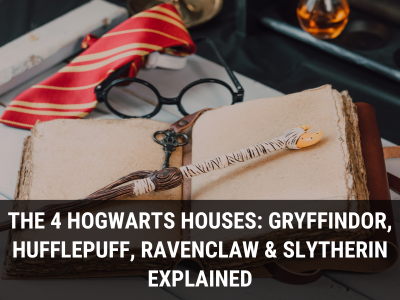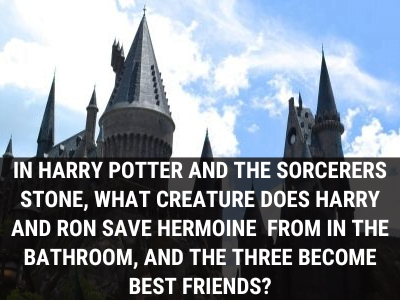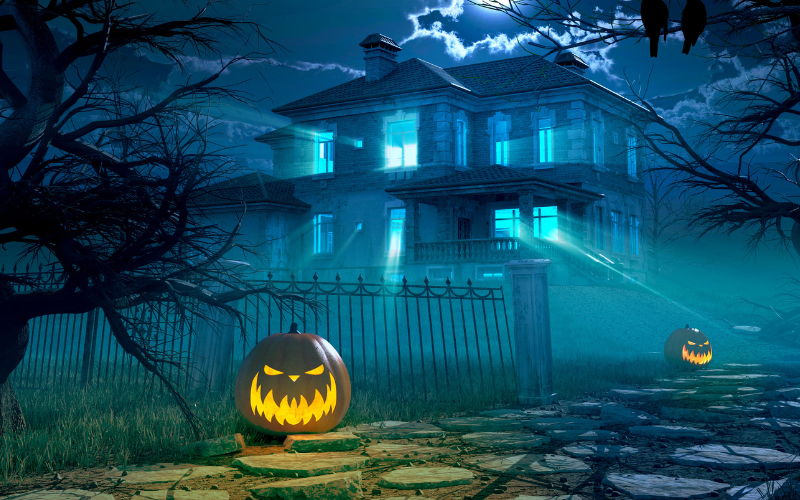
As the moon rises and the air turns crisp, the world comes alive with an eerie energy. It’s the season of Halloween, a time when the layer between the living and the supernatural is said to be at its thinnest. This spooky holiday is rich with legends, myths, and superstitions that have been passed on over centuries, capturing the imaginations of those who embrace the holiday. Below, you will find 7 of the Spookiest Halloween Legends, Myths & Superstitions. From ghostly shadows to mystical rituals, Halloween brings with it centuries of stories and traditions that continue to influence the holiday in present day culture.
The List of the 7 of the Spookiest Halloween Legends, Myths & Superstitions
1. Jack O’Lanterns and Stingy Jack
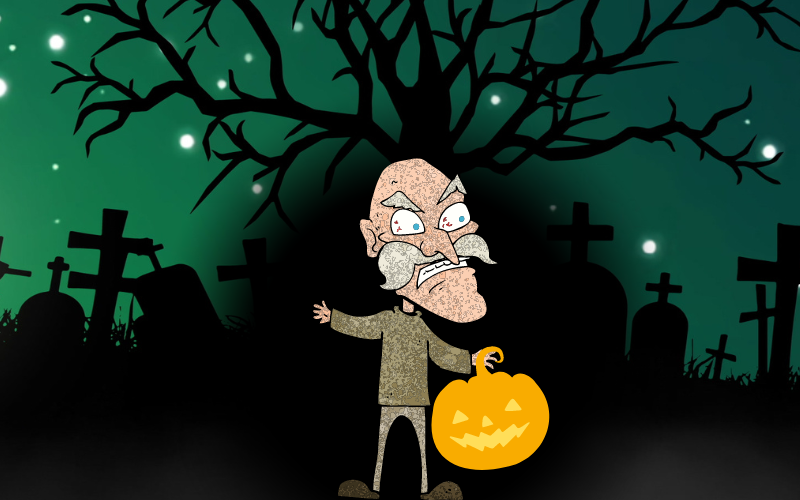
From Ireland, an old tale emerged from the previous generations. A story that not only explains the origin of the Jack O’Lantern but also speaks to the consequences of trickery and the thin line between everyday life and the supernatural. At the heart of this eerie story lies the legendary figure known as Stingy Jack.
Stingy Jack was a man known for his cunning and dishonest way of living. He roamed the land using his deceitful ways to take advantage of anyone he could. His name echoed through village streets as a warning of living a misleading life.
One fateful night, Stingy Jack found himself in a tavern, face to face with the Devil himself. The Devil was intrigued by Jack’s reputation and would offer him a dangerous wager. Jack would manage to outwit the Devil and trap him in a tree, carving a cross into the bark to keep the Devil at bay. Trapped and humiliated, the Devil promised Jack that he would never claim his soul, even upon his death.
Years would pass, and Jack’s ways would never change. He would continue to trick and take advantage of those unfortunate enough to cross his path. Eventually, as Jack’s life would draw to a close, he was denied entrance into both Heaven and Hell. True to his promise, the Devil cast Jack’s soul out into the night, leaving him to wander the earth in eternal darkness.
With nothing but a carved-out turnip and a burning coal, he fashioned a makeshift lantern to guide him through the darkness. He would forever be known now as “Jack of the Lantern,” or Jack O’Lantern.
The Jack O’Lantern’s presence became a symbol of both dread and protection. As the legendary tale continued to live on, villagers began carving their own lanterns from turnips, hollowing them out and placing candles within them mimic the haunting light that accompanied Jack on his endless journey. These lanterns, placed on doorsteps and windowsills, were believed to ward off evil spirits and the wandering souls of the dead who might cross into the world of the living on All Hallows’ Eve.
Over time, as the Irish would migrate across the world, the turnip would be replaced for the more readily available pumpkins in America. The tradition of carving these vegetable lanterns, now known as Jack O’Lanterns, became an iconic symbol of Halloween, adorning porches and adding an eerie ambiance to the darkened streets.
2. The Headless Horseman
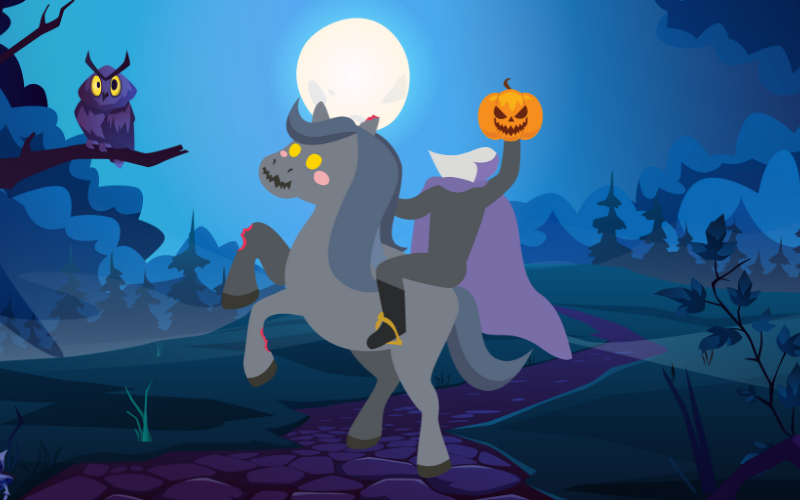
The Headless Horseman is an iconic figure of American folklore that still exists to this day. Set against the backdrop of the American Revolutionary War, a German soldier (a British ally) fighting on foreign soil is met with the tragic fate of having his head severed by a cannonball. The shock of this brutal death left his spirit in a state of eternal unrest.
It is said, that at nighttime, the Headless Horseman emerges as a restless ghost, riding through the night to reclaim his severed head. The legend is marked by the sound of hooves that can be heard through the night, as the headless horseman searches desperately for his lost head.
Adding to the eerie aura is the glow of a Jack O’Lantern carried by the Headless Horseman. The light from his lamp sends shivers down the spines of those who witness it. The horseman is a tormented soul forever caught between the realms of the living and the dead.
The tale of the Headless Horseman is more than a simple ghost story; it’s a reflection of the lingering trauma of war. As the centuries pass, the galloping hooves and the elusive glow of the Jack O’Lantern continue to etch the legend of the Headless Horseman into the heart of American folklore, a spine-tingling reminder of the thin veil between the living and the dead.
Read More Fun Facts
Learn more fun facts with Trivia Mastermind content.
3. Bloody Mary
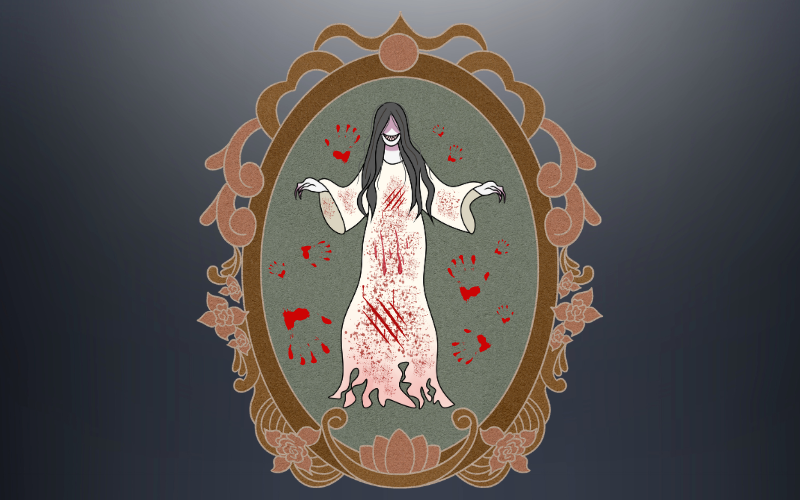
The unsettling legend of Bloody Mary unfolds like a bone-chilling game of bravery and fear, for those willing to delve into the unknown. Born from whispers and stories, this eerie myth calls upon those who seek to test their courage against the supernatural forces that supposedly linger in the shadows.
Picture yourself in a dimly lit room. In front of you stands a mirror, its reflective surface like a portal into another world. The tale begins with a simple incantation. Those brave enough to participate will chant “Bloody Mary” three times. This supposed repetition will summon a presence from the afterlife, a ghost known as Bloody Mary. According to legend, the mirror’s surface will ripple and there will stand a woman, covered in blood.
The origins of Bloody Mary’s tale vary, from historical legend to whispers shared around sleepovers. Some believe she is a vengeful spirit looking for revenge, while others believe she is a reflection of our own fears. Regardless of her origins, the legend’s power lies in the anticipation of her appearance, summoned from the depths of imagination and fear.
The legend of Bloody Mary serves as a test of nerves, a rite of passage for those who dare to confront their deepest fears. It’s a game that reflects the human fascination with the supernatural. As generations pass, the tale continues to exist in popular culture. It is a reminder that sometimes, the most unsettling stories are the ones that exist in our own minds, whether we truly believe them or not.
4. Black Cats and Witches
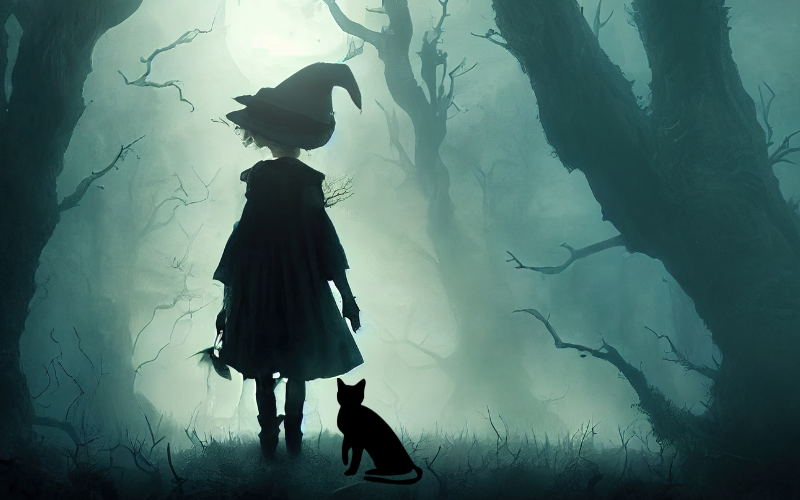
The allure of black cats and their connection to witches has been a superstition throughout history. In many cultures, the presence of a black cat has created fascination, fear, and mystery.
Dating back to medieval times, black cats were associated to mysticism. They were thought to be more than just ordinary cats; they were believed to be supernatural companions that aided witches in their spells. The connection between black cats and the unknown world of witches was the perfect combination to stoke the fears of human imagination.
During this period of time, belief in the supernatural was much more prevalent. Black cats became symbols of suspicion and fear. Their dark fur and nocturnal behavior lent themselves to the idea of secret meetings amongst witches under the moonlit sky. In this atmosphere of the unknown, black cats came to embody the fears and suspicions surrounding witchcraft.
The idea of a black cat crossing one’s path as an omen of bad luck originated from the notion that witches, disguised as black cats, would cross one’s path to cast spells or bring misfortune. As time went on, this superstition became ingrained in the collective consciousness. Even today, many people still believe that a black cat crossing their path will bring them bad luck.
However, it’s also important to note that black cats have also been cherished in other cultures. For example, in ancient Egyptian mythology, black cats were considered symbols of protection and good luck. These contrasting interpretations highlight the diverse ways in which human societies have assigned meaning to these creatures over time.
In modern times, while belief in witches and magic has waned, the connection between black cats and mysticism continues to exist. Black cats are often associated with Halloween, a holiday that embraces the supernatural. They remain fixtures in popular culture, appearing in books, movies, and art as symbols of mystery and intrigue.
Play Trivia!
Challenge yourself and play trivia questions with answers and explanations.
5. Samhain and Celtic Traditions
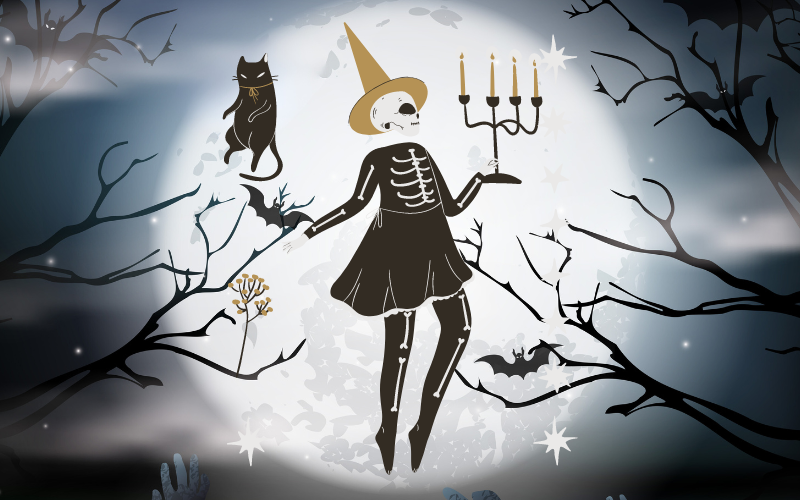
Samhain, deeply rooted in Celtic traditions, serves as a foundational pillar for the Halloween holiday we celebrate today. The ancient festival of Samhain, means “summer’s end.” It was a pivotal moment in the Celtic calendar, marking the transition from the summer season to the cold of winter.
The heart of Samhain’s significance lies in its spiritual significance. The Celts believed that during this period of time, the layer separating the realm of the living from that of the deceased was at its thinnest. It was a time when the spirits of ancestors, gods, and otherworldly entities could easily cross over into our world, bringing both positive and negative forces with them.
To ward off the evil spirits, the Celts would light massive bonfires. These fires were mainly used for protection, but they would also serve as a place where communities could come together to support one another before the coming winter.
Another custom of Samhain was the act of wearing costumes. People would wear these costumes as disguises to both honor the good spirits and ward off the evil ones. The familiar faces of these disguises were meant to appease the benevolent spirits, and also, to confuse the malevolent ones, as this would prevent them from identifying and haunting specific individuals.
As Christianity gradually took root in Celtic lands, Samhain would be influenced by the Christian holiday of All Saints’ Day, also known as All Hallows’ Day, which was originally celebrated in May. To accommodate this shift, the Church moved All Saints’ Day to November 1st, coinciding with and leading into the final day of Samhain. The evening before All Saints’ Day would come to be known as All Hallows’ Eve, which would eventually transform into the Halloween holiday we celebrate today.
Over time, the ancient Celtic beliefs would intermingle with Christian practices. This infusion would lead to Halloween becoming a unique blend of both traditions. Many of the ancient traditions are still practiced today, although, now transformed by contemporary culture.
6. Witchcraft and Divination

Halloween’s history has become synonymous with witchcraft and divination. This aspect of the holiday is rooted in ancient beliefs and practices, connected to the mystical and the unknown.
Witchcraft, has long held a prominent place in Halloween. In earlier times, Halloween marked the time when the boundaries between the material world and the afterlife were at their most delicate. The atmosphere of this time was considered a fertile ground for the practice of magic.
For many, it was believed that this was the night when the powers of witches and sorcerers were at their highest, due to the heightened spiritual energies. It was a time when herbs, crystals, and incantations could be used to unveil hidden truths.
Psychic abilities are also said to flourish during Halloween. Ancient practices such as apple bobbing and mirror gazing were used to uncover the future. The bobbing of apples was originally used to identify prospective suitors. The apples would bare the initials of suitors and the one you managed to bite would reveal your romantic destiny. This symbolic act was seen as a way to receive insights into one’s love life.
Mirror gazing, or scrying, was another mystical tradition rooted in Halloween’s history. It was believed that mirrors were portals into the spirit world. Looking into the reflective surface under the right conditions was believed to reveal glimpses of one’s future.
These practices and beliefs, while fun, also served a deeper purpose. They offered individuals a way to navigate the uncertainties of life, offering some sort of control beyond fate. The potential to harness supernatural forces and look beyond the veil of reality was a powerful and compelling idea that continues to exist in the imaginations of many people today.
7. The Samhain Cat
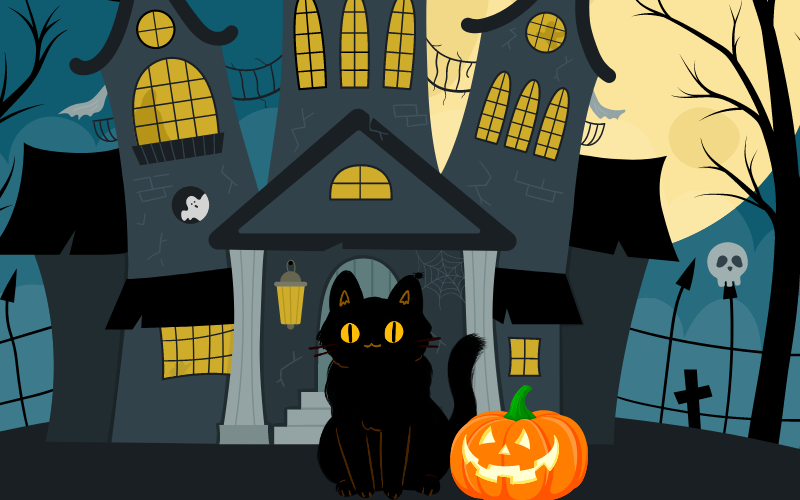
Throughout the colorful history of Celtic folklore, the mysterious Samhain cat roams with a feeling of magic, representing the idea of knowing the future and the link between our world and the spirit world. On the night of Samhain, this ghostly cat is believed to have a mystical power, telling us what will happen in the future and show how things will unfold.
The special Celtic festival of Samhain marked the time of the year when autumn would be transitioning to winter. It was believed that during this time, the layer between the living and the dead was much thinner. To honor this period, people from the community would gather around large bonfires and engage in rituals to honor the spirits of deceased ancestors.
At the heart of these traditions this was the Samhain cat. This cat was considered a special creature. It was believed that the Samhain cat could provide the people with a glimpse into the future. By monitoring the cat’s behavior, it was thought that these movements were providing insight and messages directly from the spirit world. A cat that moved confidently and purposefully might indicate a year of prosperity and success, while a hesitant or erratic stride could signify challenges ahead.
This cat was also a symbol of the connectedness between people and nature. Cats were considered important creatures due to their mysterious independence, said to be the guardians of spiritual insight, traversing the boundaries between the world of the living and the world of the dead.
Conclusion
As you delve into the topic of Halloween folklore, remember that these legends and superstitions are deeply rooted into the history of this amazing holiday. Whether you’re carving pumpkins, dressing in costumes, or sharing spooky stories, these myths remind us that there’s more to this world than meets the eye. So, embrace the eerie, explore the unknown, celebrate the enchanting tales that have been passed down through generations, and remember the traditions that have made this holiday the special day that still exists in modern culture for us to enjoy.
Read More Fun Facts
Learn more fun facts with Trivia Mastermind content.
Play Trivia!
Challenge yourself and play trivia questions with answers and explanations.
Recent Posts
Step into a realm of nostalgia as we embark on a journey through the annals of pop culture and bid farewell to 35 recently obsolete technologies. In the ever-evolving landscape of innovation, certain...

